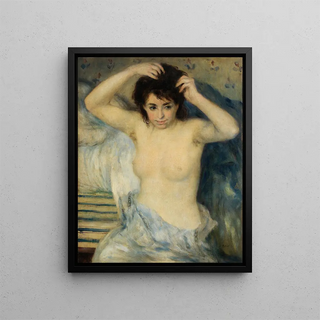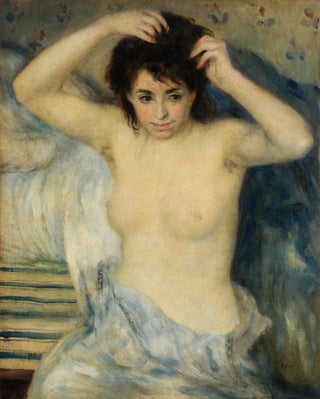Art print | Before the bath Before the bath - Pierre-Auguste Renoir


View from behind

Frame (optional)
"Avant le bain" is an iconic art print by Pierre-Auguste Renoir, a master impressionist whose genius lies in his ability to capture light and emotions. This canvas, painted in 1887, depicts an intimate scene where young women prepare to enter the water. The atmosphere conveyed by this artwork is both gentle and lively, offering a glimpse into daily life in the 19th century. Renoir, through his fluid brushwork and vibrant colors, succeeds in creating a sense of movement and lightness. This painting immerses us in a suspended moment, inviting the viewer to share a personal and universal experience.
Style and uniqueness of the work
The beauty of "Avant le bain" lies in how Renoir plays with light and color. The women's bodies, delicately modeled, seem almost to float in an atmosphere of warmth and tranquility. Shades of pink, blue, and green blend harmoniously, creating a rich palette that evokes the softness of a summer afternoon. The artist uses quick, impressionist brushstrokes that bring life to the forms and faces of the models. This unique style, characteristic of Renoir, allows us to feel the texture of the skin, the fluidity of water, and the lightness of the drapery. Every detail, though painted with apparent simplicity, reveals emotional depth and meticulous attention to composition, transforming an ordinary scene into a celebration of feminine beauty and nature.
The artist and his influence
Pierre-Auguste Renoir, a central figure of the impressionist movement, profoundly influenced the evolution of modern art. His artistic vision, focused on capturing fleeting moments and sensations, paved the way for many artists who followed. Renoir combined refined technique with a keen sensitivity to life's pleasures, which allowed him to stand out among his contemporaries. His works, often populated with scenes of daily life, highlight the beauty of human interactions and the joy of shared moments. Through "Avant le bain," Renoir reminds us of the importance of

Matte finish

View from behind

Frame (optional)
"Avant le bain" is an iconic art print by Pierre-Auguste Renoir, a master impressionist whose genius lies in his ability to capture light and emotions. This canvas, painted in 1887, depicts an intimate scene where young women prepare to enter the water. The atmosphere conveyed by this artwork is both gentle and lively, offering a glimpse into daily life in the 19th century. Renoir, through his fluid brushwork and vibrant colors, succeeds in creating a sense of movement and lightness. This painting immerses us in a suspended moment, inviting the viewer to share a personal and universal experience.
Style and uniqueness of the work
The beauty of "Avant le bain" lies in how Renoir plays with light and color. The women's bodies, delicately modeled, seem almost to float in an atmosphere of warmth and tranquility. Shades of pink, blue, and green blend harmoniously, creating a rich palette that evokes the softness of a summer afternoon. The artist uses quick, impressionist brushstrokes that bring life to the forms and faces of the models. This unique style, characteristic of Renoir, allows us to feel the texture of the skin, the fluidity of water, and the lightness of the drapery. Every detail, though painted with apparent simplicity, reveals emotional depth and meticulous attention to composition, transforming an ordinary scene into a celebration of feminine beauty and nature.
The artist and his influence
Pierre-Auguste Renoir, a central figure of the impressionist movement, profoundly influenced the evolution of modern art. His artistic vision, focused on capturing fleeting moments and sensations, paved the way for many artists who followed. Renoir combined refined technique with a keen sensitivity to life's pleasures, which allowed him to stand out among his contemporaries. His works, often populated with scenes of daily life, highlight the beauty of human interactions and the joy of shared moments. Through "Avant le bain," Renoir reminds us of the importance of






